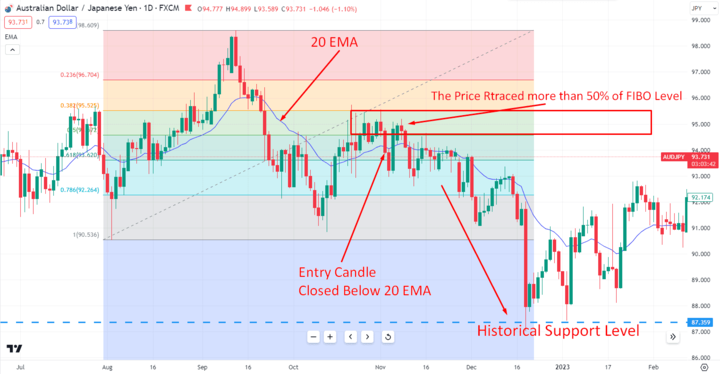Introduction
The AUDJPY currency pair represents the exchange rate between the Australian dollar (AUD) and the Japanese yen (JPY). It is one of the most popular forex pairs traded globally due to the economic significance of both Australia and Japan in the Asian region.
Fundamental analysis plays a crucial role in understanding the driving forces of the AUDJPY currency pair. It involves analyzing economic indicators, monetary policies, and geopolitical events that impact the economies of Australia and Japan, helping traders make informed decisions.
When it comes to forex trading, understanding the fundamental analysis of currency pairs like AUDJPY will allow you to make informed decisions. It will help you understand the intrinsic value of a currency pair based on economic indicators and market conditions so that you can make a sound trading strategy.
Macroeconomic Overview - Australia

Image Source: Unsplash
Australia's macroeconomic overview reveals a robust economy characterised by steady GDP growth, declining unemployment rates, and moderate inflation. The Reserve Bank of Australia's accommodative monetary policy and the government's focus on economic policies and commodity prices contribute to the country's economic performance. Conducting a thorough fundamental analysis of the AUDJPY currency pair involves studying Australia's macroeconomic overview.
A. Economic Indicators Review
Australia's economy has shown resilience in recent years, especially in 2022 and 2023. The country experienced a robust GDP growth rate, indicating a thriving economy. The unemployment rate witnessed a decline, reflecting the creation of job opportunities and improved economic conditions. As an aspiring forex trader, you must monitor these figures closely as they can impact the Australian dollar's strength against the Japanese yen.
Speaking of currency strength, inflation plays a vital role in shaping a nation's monetary policies and affects currency values. Australia experienced moderate inflation rates. The Reserve Bank of Australia (RBA) closely monitors inflation to ensure price stability. Slight fluctuations in inflation may influence the AUDJPY exchange rate, so keep an eye on inflation indicators.
B. Monetary Policy
The Reserve Bank of Australia is responsible for formulating Australia's monetary policy. During 2022 and 2023, the central bank adopted an accommodative stance to support the economy amid the challenges posed by the COVID-19 pandemic. As a result, interest rates have been kept low to stimulate borrowing and investment, potentially boosting the Australian dollar.
Anticipating changes in interest rates is essential for forex traders. While the RBA maintained stability, interest rate expectations can shift based on economic developments. Higher interest rates tend to attract foreign investors, leading to an appreciation of the Australian dollar against the Japanese yen.
C. Political Climate

Image Source: Unsplash
The Australian government's economic policies can significantly impact the country's economy and currency. Throughout 2022 and 2023, the government focused on promoting infrastructure development, trade, and innovation, fostering economic growth. Understanding these policies is crucial in assessing the AUDJPY currency pair's potential movements.
Also, Australia's economy heavily relies on commodity exports, including iron ore, coal, and gold. Commodity price fluctuations can influence the country's trade balance and economic performance, thus affecting the Australian dollar's value. As a forex trader, monitoring these commodities and their prices can give you a competitive edge.
Macroeconomic Overview - Japan

Image Source: Unsplash
Conducting a thorough fundamental analysis of the AUDJPY currency pair requires understanding Japan's macroeconomic overview. Japan's macroeconomic overview displays signs of recovery and growth, with steady GDP expansion and declining unemployment rates.
The Bank of Japan's accommodative monetary policy and low interest rates aim to support the economy amidst challenges. However, demographic challenges, such as an aging population, continue to impact Japan's economic landscape.
A. Economic Indicators Review

Image Source: Unsplash
Japan's economy displayed signs of recovery and growth during the past couple of years. The Gross Domestic Product (GDP) experienced steady expansion, indicating a positive economic outlook. The unemployment rate witnessed a decline, reflecting improved job market conditions and boosting consumer spending. As you delve into forex trading and analyze the AUDJPY currency pair, keeping an eye on Japan's GDP and unemployment rate is crucial for informed decision-making.
However, inflation in Japan remained relatively subdued during the mentioned years, with the Bank of Japan (BOJ) striving for price stability. As you monitor inflation rates, it's important to consider its potential impact on the Japanese yen's value against the Australian dollar.
B. Monetary Policy
The BOJ is responsible for Japan's monetary policy, aiming to achieve price stability and economic growth. The central bank maintained an accommodative approach, keeping interest rates low to support the economy amidst challenges like the COVID-19 pandemic. As a forex trader, understanding the BOJ's policy decisions is crucial for predicting the yen's movements.
Anticipating changes in interest rates is essential in forex trading. During 2022 and 2023, the BOJ's interest rate remained at historically low levels. However, interest rate expectations can shift based on economic developments and the BOJ's announcements. A rise in interest rates can lead to yen appreciation against the Australian dollar.
C. Political Climate
Japan's government plays a significant role in shaping economic policies. In the years 2022 and 2023, the government focused on implementing stimulus measures to revitalise the economy. As a forex trader, you should keep track of policy changes as they can influence the Japanese yen's performance.
Japan's aging population is a key demographic challenge that impacts its economy. The aging workforce and declining birth rates pose unique economic implications. As the government seeks solutions, such demographic factors may influence the yen's value.
Analysis of the AUDJPY Currency Pair

Image Source: Unsplash
The AUDJPY currency pair's analysis involves examining the correlation between the Australian and Japanese economies, the impact of GDP growth, inflation rates, and interest rates on the pair's performance. Factors supporting a bullish or bearish stance, including the Reserve Bank of Australia's and Bank of Japan's monetary policies and global commodity prices, are also considered.
Potential risks like sudden changes in global economic growth, monetary policies, and geopolitical tensions may also influence the currency pair's movements.
A. Relevant Economic Indicators

Image Source: Unsplash
The AUDJPY currency pair is influenced by the correlation between the Australian and Japanese economies. Both countries have experienced economic recovery and growth periods, impacting their respective currencies. The economic ties between Australia and Japan, such as trade partnerships and investments, further contribute to the correlation and potential movement of the currency pair.
GDP growth, inflation, and interest rates are key economic indicators significantly affecting the AUD JPY currency pair. Both countries' Positive GDP growth can boost their respective currencies, while rising inflation rates may prompt central banks to adjust interest rates. These changes in interest rates can lead to shifts in the exchange rate between the Australian dollar and the Japanese yen.
B. Factors Supporting a Bullish or Bearish Stance

Image Source: Unsplash
The Reserve Bank of Australia (RBA) plays a vital role in shaping the Australian dollar's performance. The RBA has maintained an accommodative monetary policy, keeping interest rates low to support economic growth. Such measures can support a bullish stance for the AUD/JPY.
Like the RBA, the Bank of Japan (BOJ) also influences the Japanese yen through monetary policy decisions. During the mentioned years, the BOJ also maintained low interest rates and accommodative measures to bolster the economy. However, any shifts in the BOJ's policy stance can affect the AUDJPY exchange rate.
Australia is a major exporter of commodities, and their prices significantly impact the Australian economy. Fluctuations in commodity prices, particularly in sectors like mining and agriculture, influenced the Australian dollar's performance. Hence, monitoring these prices and their potential effects on the AUD JPY currency pair is essential.
C. Potential Risks for the AUDJPY Currency Pair
Global economic conditions can have unforeseen impacts on the AUDJPY currency pair. Unexpected shifts in global economic growth, driven by factors like geopolitical tensions or natural disasters, can create volatility in forex markets and influence currency values.
Central banks' unexpected changes in monetary policies can lead to sudden shifts in the AUD/JPY exchange rate. Forex traders must be vigilant about any announcements or policy decisions made by the RBA and the BOJ that may affect the currency pair.
Geopolitical events, including trade tensions between major economies like the U.S. and China, can impact investor sentiment and cause fluctuations in the AUDJPY currency pair. As these events unfold, they may introduce uncertainty and risks to the forex market.
Trading Strategies for the AUDJPY

Image Source: Unsplash
Trading the AUDJPY currency pair requires a comprehensive approach. Utilize technical analysis to identify trends and key levels. Implement risk management by setting appropriate stop-loss and take-profit levels. Stay informed about economic events and data releases. Consider both short-term and long-term perspectives to make informed trading decisions. Remember to practice discipline and consistency in your trading strategies.
A. Technical Analysis
Technical analysis is a trading approach that involves studying historical price charts and market data to forecast future price movements. Traders use various tools, indicators, and chart patterns to identify trends, support and resistance levels, and potential entry and exit points for trades. By analyzing past price behavior, the technical analysis aims to provide insights into market sentiment in terms of helping you informed trading decisions makings. It is a valuable tool for analyzing the AUDJPY currency pair and other financial assets in the forex market.

Image Source: TradingView
Fibonacci retracements help identify potential support and resistance levels based on key price levels. These levels act as significant barriers, indicating potential turning points in the market. Combining Fibonacci with support and resistance analysis can help you identify entry and exit points with more precision.
B. Risk Management

Image Source: Unsplash
Risk management is a crucial aspect of trading that involves strategies and techniques to protect capital and minimize potential losses. Using risk management tools like setting stop-loss orders limit losses on a trade if the market moves against them. Determining position sizes based on risk tolerance ensures that no single trade significantly impacts the overall trading account. Employing risk management practices may enhance your long-term profitability and safeguard against adverse market conditions.
Implementing effective risk management is crucial to protect your capital. Setting appropriate stop-loss and take-profit levels defines the maximum amount you are willing to risk on a trade and the desired profit target. This approach helps you control potential losses and lock in profits when the trade goes in your favor.
Also, your position size should be determined based on your risk tolerance and the specific trade's stop-loss level. By managing your position size, you ensure that no single trade significantly impacts your overall trading account.
C. News Trading

Image Source: Unsplash
News trading is another trading strategy that involves capitalizing on market volatility caused by significant economic events and data releases. It requires close monitoring of economic calendars to identify key announcements. When any news events are released, the market can experience rapid price movements, providing potential trading opportunities. Using the strategy you can aim to enter and exit positions quickly to take advantage of the price volatility resulting from the news release.
Stay updated on economic events and data releases that can impact the AUDJPY currency pair. Key indicators such as GDP growth, employment data, and interest rate decisions can cause significant market volatility. Economic calendars are valuable tools to track these events. After important news is released, monitor the market's reaction and identify potential trading opportunities.
News-driven price movements can provide quick trading opportunities. However, it can be risky and requires quick decision-making and strict adherence to risk management principles to manage potential losses effectively.
Conclusion
Based on our analysis, the AUDJPY currency pair exhibited signs of a positive economic outlook, with both Australia and Japan experiencing periods of economic recovery and growth during 2022 and 2023. The Reserve Bank of Australia and the Bank of Japan's accommodative monetary policies and supportive economic policies contributed to the bullish sentiment. Positive global commodity prices also further boosted the Australian economy, supporting a bullish stance for the AUDJPY currency pair.
Considering the fundamental analysis and trading strategies discussed, trading the AUDJPY currency pair requires a well-rounded approach. Technical analysis tools can complement the insights gained from fundamental analysis, identifying trends and entry/exit points, and incorporating risk management techniques is crucial to safeguarding capital.




